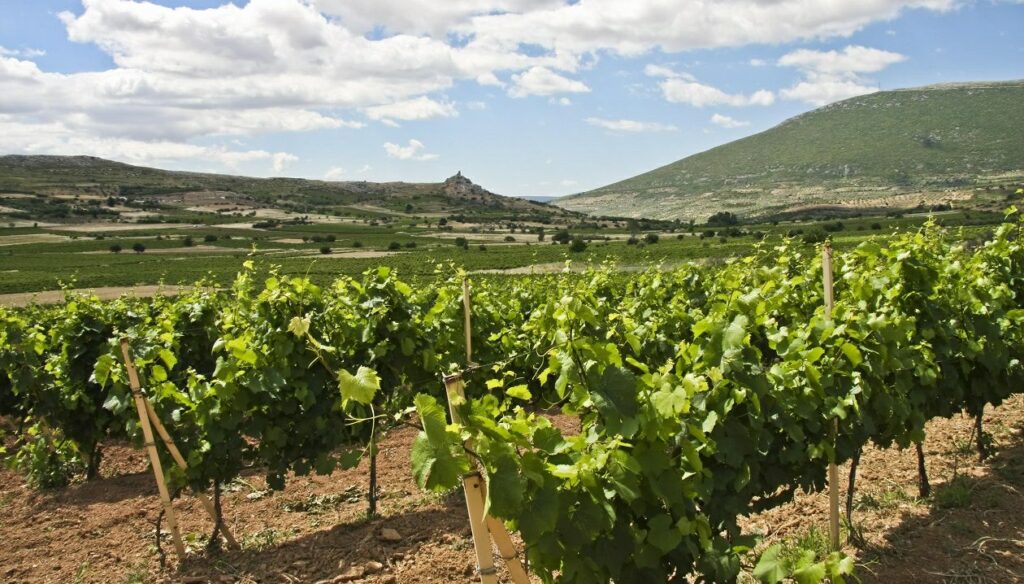The Vineyards of Attico-Voiotia
Our Varieties
Xinomavro A traditional Greek grape variety known for its intense aromas and distinctive character.
Xinomavro
One of Greece’s most iconic and historic red grape varieties, Xinomavro is primarily cultivated in Northern and Central Greece, especially in the region of Macedonia. It is renowned for its distinctive flavor profile and aromatic intensity.
The grapes are small, with thick skins and a deep red to almost black-red color. They ripen slowly, which allows for the development of concentrated aromas and flavors.
Wines made from Xinomavro typically display medium to high acidity, firm tannins, and rich fruit-driven aromas such as cherry, blackberry, and sour cherry, often evolving into spicy and nutty notes with aging. Barrel maturation is commonly used to add depth and complexity to the final wine.
Thanks to its structure, Xinomavro is well-suited for long-term aging, as both its acidity and tannins support graceful evolution over time. These wines pair beautifully with red meats, traditional Greek cuisine, and aged cheeses.
Assyrtiko – The Greek Grape with International Recognition
Assyrtiko
Assyrtiko – Greece’s Noble White Grape
Assyrtiko is a dynamic white grape variety originally rooted in Santorini, yet capable of thriving in warm-climate regions across Greece. While it began as the flagship variety of the island (Assyrtiko of Santorini), it has now spread widely throughout the country and has earned its place as one of Greece’s most important native varieties in terms of quality.
Assyrtiko typically produces dry white wines, some of which undergo barrel aging. It is regarded as one of the finest grapes of the Greek vineyard, with limitless potential and rare virtues.
In the glass, Assyrtiko displays pale straw color with green and golden hues, occasionally likened to the soft glow of a pomegranate seed. On the palate, it is rich and full-bodied, marked by its vibrant acidity and characteristic minerality. The flavor and aroma profile is deeply influenced by the terroir in which it is grown.
It expresses aromas of fresh yellow fruits and citrus, often layered with flinty, saline, and mineral undertones. These wines are known for being both austere and elegant, with a dense structure and firm acidity, appealing to those who seek white wines with an uncompromising, intense character.
Thanks to its naturally high acidity, Assyrtiko has excellent aging potential. Under proper cellaring conditions, it can evolve gracefully for five to ten years—or even longer—developing richer textures and complex tertiary aromas over time.
Whether unoaked or barrel-aged, all well-crafted Assyrtiko wines are built to last. As for its sweet expressions, they are virtually eternal, with time not only preserving them but enhancing their depth and balance.
Assyrtiko stands apart from the average, “commercially friendly” white wine. It speaks to those who appreciate structure, tension, and individuality—and it pairs beautifully with grilled fish, seafood, and Mediterranean cuisine.
Chardonnay – an elegant and versatile variety
Chardonnay
Chardonnay – One of the World’s Most Popular and Adaptable White Grapes
Chardonnay is one of the most widely cultivated and popular white grape varieties in the world. Originally from Burgundy, France, it is now grown in many wine-producing regions due to its versatility and ability to adapt to a wide range of climates and soils.
Chardonnay wines come in a broad range of styles—from light and fruity to rich and full-bodied—often showing notes of butter and vanilla when aged in oak barrels. Its typical aroma profile includes green apple, lemon, pineapple, peach, and other tropical fruits.
Chardonnay is also a key grape variety in the production of sparkling wines, including Champagne.
Its flexibility makes it an ideal companion to a wide variety of dishes—from seafood and white meats to creamy sauces and cheeses.
Syrah – The International Red Grape Variety
Syrah
Syrah – A Bold and Complex International Red
Syrah produces some of the darkest and most full-bodied red wines in the world. Its flavor profile ranges from dark fruits—such as blackberries, ripe black raspberries, plums, and cassis—to savory elements like black olives.
When tasting Syrah, one is often met with an intense burst of flavor upfront—almost like a punch—yet it gradually softens, leading to a peppery, spicy finish. Because of this front-loaded intensity, Syrah is frequently blended with grapes that add mid-palate roundness, such as Cabernet Sauvignon—a favored blend in Australia. This helps create a more balanced and structured wine.
Traditionally in France, Syrah is blended with lighter-bodied Grenache or the richer Mourvèdre, forming the classic Côtes du Rhône blend, known for its complexity and depth.
Due to its rich body and bold character, Syrah pairs beautifully with flavorful dishes—from grilled meats to blue cheese—but the key is to avoid overpowering the wine’s more subtle nuances.
There are several stories surrounding the origin of Syrah. One legend claims it was brought from Iran to Marseille, possibly linked to the ancient city of Shiraz. However, a 1999 genetic study conducted at the University of California confirmed that Syrah is a natural cross between two obscure French grape varieties: Dureza and Mondeuse Blanche.
Garnacha Tinta or Grenache Rouge
Grenache Rouge
Grenache – A Rediscovered Red with Remarkable Depth
Grenache (known in France as Grenache Noir) is believed to have originated in Aragon, Spain, before spreading to Rioja and eventually across the Pyrenees into southern France, reaching as far as the Rhône Valley.
Due to its oxidative character, Grenache was long underestimated by wine professionals. However, it has since earned great respect, especially through its exceptional expression in Châteauneuf-du-Pape, as well as in Australia’s Barossa Valley. The variety also produces outstanding rosé wines, particularly in Provence, where it plays a leading role. Its wines are known for their deep red color with violet hues.
The international wine world began to truly recognize Grenache’s full potential when the Spanish region of Priorat re-emerged on the global stage, offering bold, high-quality wines that highlighted the grape’s capabilities—especially when sourced from old vines with naturally low yields.
Grenache thrives in warm climates and requires time and sun to fully ripen, making it particularly well-suited to Mediterranean regions like Greece. Despite this, during the wave of international varietal plantings in Greece 30–40 years ago, Grenache fell out of favor and was often replaced or removed, just as it was in France and Spain—mistakenly considered a second-tier grape.
In truth, Grenache Rouge is a high-quality red variety, producing wines with vibrant color, generous structure, and a rich mouthfeel. When used in blends, it contributes to color stabilization, adds roundness, and enhances the organoleptic character of the final wine.
Where Time Stands Still
Our Land

Mount Kithairon – A Place of Myth, History, and Strategic Importance
In ancient times, Mount Kithairon marked the border between Megaris and Boeotia. In Greek mythology, it is said that Orpheus performed sacred rites here, introducing the worship of Dionysus to mainland Greece.
Due to its geographic position, Kithairon was historically a place of great strategic importance, as it served as a natural passage between Attica and Boeotia. Control over these passes played a key role in ancient military and political affairs.
Today, Mount Kithairon is home to several important landmarks, including:
– the fortress of Aigosthena (Porto Germeno),
– the Monastery of Saint Meletios,
– the archaeological sites of Plataea and Leuctra,
– and the Monastery of the Holy Trinity, among others.
